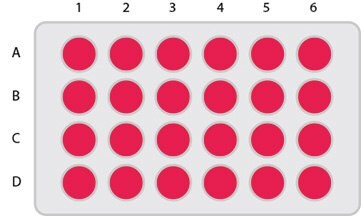HomeReaction Design & OptimizationStep-by-Step Guide for KitAlysis™ High-Throughput Metal Scavenger Screening Kit
Step-by-Step Guide for KitAlysis™ High-Throughput Metal Scavenger Screening Kit
2 x 12 pre-weighed scavengers / resins
Useful for:
Broad-spectrum metal removal
Impurity removal
Color treatment
Materials required – set up:
- 1 mylar bag from the KitAlysis Metal Scavenger Reaction Screening Kit and you will use the following components
- 2 x 12 pre-weighed scavengers / resins in glass vials topped with cap mat
Additional (not included) items needed:
- 1 (1 mL) syringe with needle or 1 (1 mL) pipette with tips
- 50 mL flask
- Solvent (DCM, THF, EtOAc, DMF, MeOH, Toluene, Water (pH 2-10) or any other solvent in which your substrate is soluble)
- Orbital shaker for 96 well plates (the use of stir bar is not recommended with some of the resins)
- Your substrate: metal contaminated crude or purified material
Loading options:
Each kit can be used to screen 12 different scavengers, each at high (50 mg/vial) and low (10 mg/vial) loadings. Stock solution guidance for various w/w% is provided below. For instance, in a single kit, both 100 w/w% and 20 w/w% scavenger loading can be screened with a given stock solution.
Kit Components and Product Information
- The screening sets come pre-loaded with 12 scavengers / resins (10mg or 50mg) in each vial according to the following design.
- Individual kit components are available in research scale at sigmaaldrich.com

All contents in the foil bag are weighed, plated, packed, and sealed in a glove box under nitrogen.
Set Up Procedure:
- Remove the silicon cap-mat from the plate and open each reaction vial carefully without changing its position on the plate. No pre-wetting or pre-activation of the resins is required.
- Using a pipette or a syringe, add 1 mL of the stock solution to each reaction vial.
- Re-cap all reaction vials.
- Set the plate on the orbital shaker and stir for 4-16 hours (make sure you have adequate agitation). If you don’t have access to an orbital shaker, you can add stir bars to each vials and use a stir plate (this is not the preferred agitation method).
- At the end of the stirring time, the plate can be centrifuged or the samples can be filtered using an inline syringe filter.
- The metal scavenging process can be quantified by standard analytical techniques (ICP-OES, ICP-MS) by sampling the supernatant with a clean pipette.
Optimization tips:
- Once the best scavenger and loading has been identified using the above procedure, a number of steps can be undertaken to further optimize the scavenging results.
- Increasing reaction time
- Increasing / decrease loading of the scavenger
- Running the reaction at higher temperature
- Screening different solvents
- These steps can be done in standard glassware using bulk scavenger available from sigmaaldrich.com
Additional Recommended Materials (Sold Separately)
- Z683809: 10-100 uL pipette
- Z640220: 2-200 uL pipette tip refill
- Z683825: 100-1000 uL pipette
- Z640247: 50-1000 uL pipette tip refill
- Z192570: 2 inch needles for ease in ampule solvent extraction
- Z230723: 1 mL needle for accurate solvent volume extraction from ampule
- 270997: Dichloromethane (anhydrous)
- 270989: Ethyl acetate (anhydrous)
- 186562: Tetrahydrofuran (anhydrous)
- 227056: N,N-Dimethylformamide (anhydrous)
- 244511: Toluene (anhydrous)
登录以继续。
如要继续阅读,请登录或创建帐户。
暂无帐户?